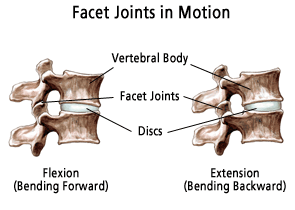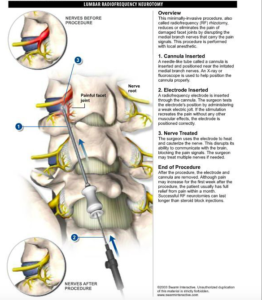26 Jun Procedure Spotlight: Radiofrequency Ablation
 If your pain is concentrated in your neck, back or legs, it can be hard to do even basic exercises like walking. Sometimes, facet joint injuries cause this type of pain. If this is the case, radiofrequency ablation may be a treatment option. Keep reading to learn more about radiofrequency ablation and facet joint injuries.
If your pain is concentrated in your neck, back or legs, it can be hard to do even basic exercises like walking. Sometimes, facet joint injuries cause this type of pain. If this is the case, radiofrequency ablation may be a treatment option. Keep reading to learn more about radiofrequency ablation and facet joint injuries.
WHAT IS RADIOFREQUENCY ABLATION?
Radiofrequency ablation (RFA) is a procedure to treat lower back, hip, groin, buttock, neck pain and headaches. The procedure uses radio waves to generate heat. Then, the heat “burns” nerves to disrupt their function. Disrupted nerve function can ease pain from facet joint injuries by blocking pain signals. Usually the nerve block lasts for 6-9 months, although it may last as short as 3 months or as long at 18 months.
 WHAT ARE FACET JOINTS?
WHAT ARE FACET JOINTS?
Facet joints are small joints on either side of the spine that guide movement. Facet joint injuries are most commonly from problems like arthritis or injury. Usually, injuries to the cartilage in the joint or connecting ligaments can lead to facet joint pain. Facet joint injuries can cause pain in many areas. For example, pain in the buttocks may be from lumbar injury; upper back pain from thoracic injury; and neck pain from cervical injury. The best way to diagnose facet pain is to block the pain signal from the facet joints. Then, doctors may ablate the nerve once they locate the offending pain signal.
WHO IS A CANDIDATE?
Arthritis and injury to facet joints are the most common reasons for radiofrequency ablations. For these patients, RFA blocks the nerve’s ability to send pain signals. Sometimes, patients with reflex sympathetic disorder (RSD) may benefit from radiofrequency ablation. In addition, some degenerative disc problems, like occipital neuralgia, may be treated with ablation.
To qualify for radiofrequency ablation, patients must respond well to diagnostic injections and any trial injections. Most patients try more conservative treatment options like anti-inflammatory medication, chiropractic or physical therapy sessions.
 WHAT ARE THE BENEFITS?
WHAT ARE THE BENEFITS?
Radiofrequency ablation disrupts nerve conduction, specifically interrupting pain signals. This should help relieve pain controlled by the blocked nerve. Sometimes after a nerve block, it becomes clear that there is pain from the other areas as well. This is common for patients with multiple injuries or
WHAT TO EXPECT DURING RFA?
Radiofrequency ablation typically takes anywhere from about twenty minutes to one hour. Patients will either lay on their stomach or back, depending on the location of the pain and ablation.
First, the surgical team cleans and numbs the skin on the back with antiseptic and a local anesthetic. Then, doctors use fluoroscopy, or x-ray guidance, to place the needle. Once they place the needle, the provider inserts a special electrical needle tip. This specialized needle stimulates the nerve. This helps them identify the offending nerve. Finally, the needle is heated to “burn” the identified nerve semi-permanently. The provider removes the needle and bandages the injection site. Patients may be sore for a few days, and it may take 2-3 weeks for full pain relief.
IS RADIOFREQUENCY ABLATION SAFE?
Radiofrequency ablation is a proven treatment for some types of pain. It generally has very few associated complications and effective for most patients. As with any injection, there is a slight risk of infection and bleeding at the injection site. For more information or to schedule your pain assessment, please call 615.941.8538.
 For more information on The Pain Management Group, please visit thepainmanagementgroup.com or schedule an appointment at one of our locations throughout Middle Tennessee.
For more information on The Pain Management Group, please visit thepainmanagementgroup.com or schedule an appointment at one of our locations throughout Middle Tennessee.
We are committed to providing individualized care and vow to treat each patient with compassion and respect, never turning anyone away. Our physicians are fellowship-trained pain specialists who utilize a combination of interventional procedures and medication management services to tailor a personalized care plan for each patient’s long-term pain relief.




